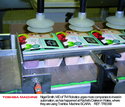Make life easy with robots
5 November 2010Robot manufacturers are working to make it easier for companies to graduate to systems that are able to raise output and profits at a stroke, writes Joanne Hunter.
Making it easy to introduce robotics is part of a constant campaign by robot manufacturers to reduce the fear of the unknown that they believe holds back potential robot users.
Directors considering an investment in robots are not immune to a sense of hesitancy to taking the leap, says Nigel Smith, Managing Director of TM Robotics (Europe). He believes their fears are largely unfounded: “All new technologies go through an acceptance phase, which can last for years or even decades, before they become commonplace. In my experience the biggest single barrier preventing greater uptake of industrial robots in packaging is the belief that robots are in some way ‘difficult’.
“The perception is that robots are too difficult to buy; they will take too long to integrate, be too difficult to maintain, or will create problems where the existing system doesn’t. People are often willing to put up with the old system being slow, creating lots of unusable product and costing substantially more than a robotic equivalent because of this fear,” asserts Mr Smith.
On the contrary, industrial robots have a relatively short lead time, he says, and they can be integrated as part of a line upgrade without extending the duration of the upgrade dramatically or, in some cases, at all. “And robots are typically easier to maintain than equivalent, older technology, such as hydraulic automation. In reality robots tend to solve problems far more often than they create.”
Savings
Savings possible are outlined below. Adding these to the benefits and subtracting the costs will indicate the potential return on investment. Many companies, including TM Robotics, will offer free intiial help with the calculation.
¦¦ Labour costs saved by re-distributing existing workers elsewhere in the company;
¦¦ Maintenance costs saved;
¦¦ Changeover savings;
¦¦ Further overheads reduced because manual labour is no longer required.
The future
The robot industry is always innovating to help improve ROI. TM Robotics focuses on easier use. For example, a SCARA robot starter pack allows customers to learn about robotics on a small scale before launching onto larger projects. Its enhanced vision software makes integration, deployment and re-programming even easier. A user can now create robot programs after some basic training, while a more advanced user has the tools to control an entire manufacturing cell.
Robots get fresh with flow-wrappers
Italian manufacturer PFM Packaging Machinery has a dedicated department to integrate robotics and flow-wrapping machinery in the dairy, meat and fresh produce industries.
PFM works with robot manufacturer ABB and uses the company’s FlexPicker to operate at speeds up to 150 picks/min.
“Understanding of the application and the flow-wrapping process is the key element in successful integration of robotics, so PFM decided early on to employ its own specialists, versed in both technologies,” explains Sales and Operations Director Chris Bolton.
PFM and ABB co-operated to produce a loading system for pulp trays of fruit such as pears that require orientation.
“Up to now much of this work has been carried out manually, but falling costs of robotics and payback times of 18 months or less are persuading packers across Europe, even in areas of low labour cost, that automation with the ABB robot is an economic proposition,” says Mr Bolton. “The vision system can also provide reliable quality control over undersized, damaged or blemished product.”
In the cheese industry PFM robots on flow-wrappers provide packers with automatic means of bringing wedges, which emerge from the weigh-cutting machine facing alternately left and right, into a single orientation. Simple press-button programme changes cater for different size wedges and orientation for wrapping.
Current applications in the meat industry include 24-hour operations handling sausages and salami arriving on a conveyor at random and transferring the products to the flow-wrapper infeed in the correct orientation and pitch. Faulty product can be identified and rejected.
Take the plunge: Robots help raise output and profits. Toshiba PFM system handling sausages and salami arriving on a conveyor at random and transferring the products to the flow-wrapper infeed in the correct orientation and pitch. PFM



